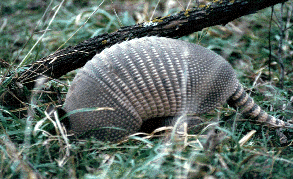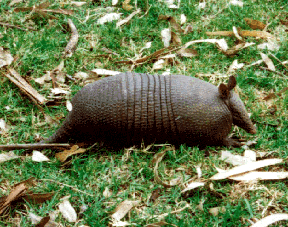

LIKE A SUIT OF ARMOR, plates of skin-covered bone protect most of the armadillo's body. Armadillo men "little armored one" in Spanish. The large, solid plates are connected by overlapping bands that partly circle the animal's middle and allow it to bend. The armor protects the armadillo from thorns and branches and sometimes from its enemies.
Armadillos are well equipped for digging. The stocky animals have short front feet with powerful, curved claws. They used these to dig underground burrows where they sleep and raise young. Because an armadillo can hold its breath as long as six minutes, it does not breath in dirt when it is digging. Nine-banded armadillo can even cross rivers by holding its breath and walking along the bottom.


There are twenty different kinds of armadillos. All of them live from Mexico through most of South America. And one kind is also find in the southern United States: the nine-banded armadillo. Actually, this long-nosed armadillo sometimes has only eight bands between its shoulder and hip plates.
Armadillos come in many sizes. The pink fairy armadillo is the smallest-6 inches (15cm) from head to tail. The giant armadillo is ten times as long-measuring about 5 feet (152 cm).
Armadillos are timid animals. When frightened, they run for their dens. Inside their burrows they are safe. The pink fairy armadillo often blocks the opening of its den with its blunt, scaly hind end. The pichi (say PEA-chee) armadillo wedges itself into a shallow burrow with the toothlike edges of its jagged scales. It is difficult for an enemy to drag it out.
An armadillo can also protect itself by digging a new place to hide. It rapidly makes a tunnel and vanishes before a predator's eyes. Finally, the three-banded armadillo can roll its body into an armored ball. Such enemies as foxes or wolves cannot get a grip on the smooth plates. Other armadillos curl up only partway to protect their soft bellies.
Most armadillos live alone, but some kinds live in pairs or in small groups. Armadillos may even share a burrow. Most dig their dens in open grasslands. But giant and nine-banded armadillos also live in forest underbrush.
Armadillos make snorting noises as they move about. Hikers near sand dunes in Florida-and in other dry parts of the southern United States-often hear armadillos sniffing for grubs in the tall grass. The animals probably depend on their sense of smell to find food. Some burrow into termite mounds and stay there all day, feeding on insects.
Ants and termites are an armadillo's favorite foods. The animal pushes its worm-shaped tongue far into an insect nest. Its tongue comes out covered with insects. These are quickly gobbled down. Armadillos also eat snakes, worms, snails, beetles, roots, fruit, and sometimes dead animals.
Most armadillos give birth to one offspring or to twins. But the nine-banded armadillo bears four identical offspring. The young in each litter are the same sex-all male or all female.
INFO
Armadillo:
Length of head and body: 5-37 in (13-94cm); tail, 1-21 in (3-53 cm)
Weight: 3 oz-120 lb (85 g-54 kg)
Habitat and Range: grasslands and open forests from the southern United States through most of South America.
Food: ants, termites, worms, snails, beetles, roots, fruit, snakes and dead animals
Life Span: 4 to 16 years in captivity, depending on species and is not known for all